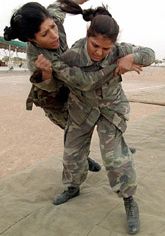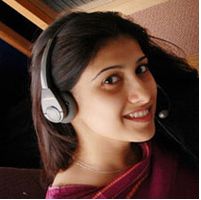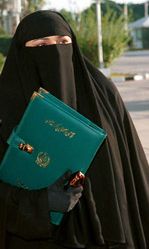Will the Real Pakistani Woman Please Stand Up?
By Shimaila Matri Dawood | News & Politics | Published 20 years ago
Who is the Pakistani woman?
Does she have an identity?
From teacher-preacher, fundamentalist icon Farhat Hashmi, covered head-to-toe in billows of black, to sassy supermodel, Iraj, clad in just a thong bikini, two images, equally compelling, vie for supremacy in urban Pakistan today. Both tell completely different sides of the Pakistani woman’s story. But it is, in fact, these two extremes that capture the very essence of the conflicting realities that govern the life and frame the identity of the Pakistani woman today.
For the daughter of privilege, a select ‘liberal’ elite, life is one long soiree. Essentially nocturnal by habit, she’s seen at all the haunts the ‘beautiful people’ congregate at — intimate gts, extravaganzas for charity, midnight balls at the beach. Daytime pursuits include ‘doing lunch,’ at any one of a clutch of trendy city eateries, a few select fashion shows, and if a trip abroad hasn’t been on the itinerary, working her way to an actual tan by the pool at home or in a zealously private club. And ‘intellectual’ forays could mean taking in the Vagina Monologues, giving her and the girlfriends something to talk about for months, a good French subtitled flick on television, or an afternoon with Ms Nair or Arundhati Roy at a local hotel.
Not everyone’s life is, of course, utterly devoid of meaning. Many of the young women of this group are working, or aspiring to work, having dutifully earned themselves that ubiquitous ‘bachelors’ degree at one or another college overseas. Armed with a savvy born of travel and independent living and the security of being someone’s daughter, these young women are ready to take on the world.
And following close on their heels are the young women who may not have had all the trappings, but make up for it by nursing even more ambitions to see, do and have it all. This is the child of the upper middle class who has the education, push and drive to get up and go go. And so she does. She works — on television, on stage, in a bank or multinational — and climbs her way up the corporate ladder or earns her wings to fly. This is a new Pakistani woman, but the only identity she has is the fact that she doesn’t really have one. Largely unfamiliar — and equally uninterested in her culture, her language, her roots — she could be anyone, anywhere. Says journalist Mahreen Khan, “At a dinner party at somebody’s house, I was the only one who wasn’t drinking or smoking. And I was the one who had moved to Pakistan from England and been raised abroad.”
The fact is, this class of Pakistani woman is out there, and in your face. And because she is on billboards, society magazines, even on television, you could be forgiven for thinking this is the new Pakistani woman.
The fact, however, is that she comprises just under two per cent of the female population.
What about the other 98 per cent?
 Many continue to be abused, beaten, raped, and killed — with the tacit consent of governments unwilling to take on their cause. For the large swathes of Pakistani womanhood who toil in fields, and know of little outside their villages, life carries on as it has centuries before. According to a UNDP report in 1999, Pakistan was second from the bottom of 102 countries with respect to Gender Empowerment. The development agency described “a strong ‘inside/outside’ dichotomy in Pakistan, where women are restricted to the ‘inside’ space of home and household, embodied in the tradition of veiling. This restricts women’s access to education, employment, training opportunities and social services,” it said.
Many continue to be abused, beaten, raped, and killed — with the tacit consent of governments unwilling to take on their cause. For the large swathes of Pakistani womanhood who toil in fields, and know of little outside their villages, life carries on as it has centuries before. According to a UNDP report in 1999, Pakistan was second from the bottom of 102 countries with respect to Gender Empowerment. The development agency described “a strong ‘inside/outside’ dichotomy in Pakistan, where women are restricted to the ‘inside’ space of home and household, embodied in the tradition of veiling. This restricts women’s access to education, employment, training opportunities and social services,” it said.
For these women, little has changed since then. Although they participate actively in the family and farm affairs, their unpaid work is perceived as a social duty rather than an economic contribution. For women, the equality provided for in the Constitution is negated by discriminatory ordinances — the Hudood being the most heinous, with over 210,000 cases under process in our legal system in 2003 — and others such as the qisas and diyat laws. When it comes to resolving disputes, misogynistic panchayats and jirgas continue to dispense a crude justice of their own. Take the case of Samia Sarwar, butchered by her own family for defying tradtional customs of family honour, or more recently that of Shaista Almani, forced into exile for marrying out of her family. Many more don’t live to see another day.
Crimes against these women also grab attention at home and abroad, feeding the standard repressed representation of Pakistani women.
Given the apathy of the privileged few, and the impotence of the many, is there any hope for Pakistani womanhood at all?
Are any on the road to empowerment and a responsible, fulfilled life?
While Pakistan’s elite has always existed in almost another firmament, and with its lower classes remaining mired in the past, the burden of pursuing a true modernity has fallen on the burgeoning middle class.
Women who one might have previously considered unsuitable for white collar work — perhaps because they spoke only in Urdu and wore the traditional hijab, kameez, shalwar, are now undergoing a metamorphosis. Thrust out of the kitchen and into the workforce — partly out of necessity, partly out of desire — these middle class soldiers are silent revolutionising the face of the Pakistani female. With increasing exposure to western ideas through the internet, television and print media, as well as access to education, middle-class women are pushing Pakistan up the Gender Development Index.
 In 1999, Pakistan was ranked 120 out of 146 countries by the UNDP, as it had the lowest female labour force participation rate and the lowest number of women in parliament. Five years down the road, these statistics have improved considerably. Female literacy is at 20 per cent and with 33 per cent of the seats reserved for women in the local bodies, their participation in politics has also risen. Today, women make up 22 per cent of Pakistan’s parliament, including two federal ministers, five state ministers and seven provincial ministers. At the grassroots level, there are 40,000 women councillors, some mayors and deputy mayors. Approximately 27,000 have been promoted through a women’s political participation project. And although the national average of female employment five years ago was a lowly 5.43 per cent, according to a 2003 economic survey, women’s participation in the workforce has increased to 8 per cent. And in the urban areas, it could even be as high as 30 per cent.
In 1999, Pakistan was ranked 120 out of 146 countries by the UNDP, as it had the lowest female labour force participation rate and the lowest number of women in parliament. Five years down the road, these statistics have improved considerably. Female literacy is at 20 per cent and with 33 per cent of the seats reserved for women in the local bodies, their participation in politics has also risen. Today, women make up 22 per cent of Pakistan’s parliament, including two federal ministers, five state ministers and seven provincial ministers. At the grassroots level, there are 40,000 women councillors, some mayors and deputy mayors. Approximately 27,000 have been promoted through a women’s political participation project. And although the national average of female employment five years ago was a lowly 5.43 per cent, according to a 2003 economic survey, women’s participation in the workforce has increased to 8 per cent. And in the urban areas, it could even be as high as 30 per cent.
Thousands of women from middle and lower income families across Pakistan today engage with the state or civil society in professional capacities. More women from humble backgrounds are starting their own business in competitive fields such as restaurants, textiles and schools. In lower income areas, homes are being turned into workshops and businesses including garment-stitching, flower-making, fruit-packaging and cardboard box-making. Consequently, demand for credit has also skyrocketed. According to Zarine Aziz, President of First Women’s Bank Limited, “more then 27,000 women borrowers have been financed by FWBL and approximately 8.1 billion in loans have been dispersed in the micro-loan category.”
These trends mark a substantial turnaround from the sheltered position of women in the past. The rising rate of female participation in traditionally male-domimated fields such as the police, armed services, sole-proprietorships, banks, restaurants, television and public offices, is testament to that. Says city planner Arif Hassan, “a sizable number of new generation lower-middle class Pakistani women are working in many white-collar jobs in the city. They are bank managers, college teachers, telephone operators, receptionists, doctors, engineers, IT professionals and technicians — para-professionals of all descriptions.”
 Like the elite liberal woman, and her more repressed counterpart, these women are now breaking into headline news. Take Captain Tarana Saleem, for instance, Sindh’s first woman pilot, or Lakshan bibi, the first Chitrali woman to become a member of the Peshawar Flying Club. Then there are women such as Asma Shirazi, a Geo journalist and rising star of the Pakistani news circuit, who actually breaks the news. Says Asma, “Although my parents were reluctant to let me join the electronic media, they soon gave in and supported my ambition. Today there are many more opportunities in the media for women. And it feels so great to be part of the industry and have such an exciting job.” Programmes such as Uljhan Suljhan, or Question Time Pakistan, both presented by a new breed of electronically savvy journalists, and addressing issues relevant to women, have also increased women’s visibility in the public domain.
Like the elite liberal woman, and her more repressed counterpart, these women are now breaking into headline news. Take Captain Tarana Saleem, for instance, Sindh’s first woman pilot, or Lakshan bibi, the first Chitrali woman to become a member of the Peshawar Flying Club. Then there are women such as Asma Shirazi, a Geo journalist and rising star of the Pakistani news circuit, who actually breaks the news. Says Asma, “Although my parents were reluctant to let me join the electronic media, they soon gave in and supported my ambition. Today there are many more opportunities in the media for women. And it feels so great to be part of the industry and have such an exciting job.” Programmes such as Uljhan Suljhan, or Question Time Pakistan, both presented by a new breed of electronically savvy journalists, and addressing issues relevant to women, have also increased women’s visibility in the public domain.
But has the increasing participation of women from conservative households in the organised labour force translated into any significant empowerment on the ground?
 Opinions remain mixed. While a study conducted by PILER, in 2003, revealed that bringing home a paycheck did not necessarily translate into increased or equal decision-making at home, more and more women of the middle and lower middle classes say it has enriched their lives (see chart). Twenty-five year old Zenubia Qureishi, who works for a leading call centre in Karachi, is a case in point. Even though the demands of her job include working nights, she is one of the many girls on staff, who comprise 22 per cent of the labour force, willing to take night shifts. “The job not only makes you a good customer support executive, but also a better person. I have become more sharp and punctual,” she says. “I also earn more than an MBA grad which is a fantastic reason to show up at night with a smile on your face!”
Opinions remain mixed. While a study conducted by PILER, in 2003, revealed that bringing home a paycheck did not necessarily translate into increased or equal decision-making at home, more and more women of the middle and lower middle classes say it has enriched their lives (see chart). Twenty-five year old Zenubia Qureishi, who works for a leading call centre in Karachi, is a case in point. Even though the demands of her job include working nights, she is one of the many girls on staff, who comprise 22 per cent of the labour force, willing to take night shifts. “The job not only makes you a good customer support executive, but also a better person. I have become more sharp and punctual,” she says. “I also earn more than an MBA grad which is a fantastic reason to show up at night with a smile on your face!”
While the image of a lone woman out of the home in the darker recesses of night may still be unpalatable for many — attitudes toward women in the workplace are changing. Whereas an ILO report published in 2003 stated “the social disapproval of women working outside the home translates into the invisibility of women in the labour force,” says Geo’s Asma,” After men realise that you are capable, hard working, and here to stay, they go out of their way to help you.” Encouraged by this hidden generation’s economic participation, today’s business savvy male — and female — entrepreneurs have realised that they can no longer continue to ignore their demand for education or skilled training — even transport. Take Uzma Gul of Varan Tours, Rawalpindi, for example. Although initially discouraged by family members, and resented by her staff who appeared uneasy with a woman boss, Uzma persevered with her vision: a quality transport service for the working women. She established a transport company with just one bus and today her company owns a fleet of 75 buses, running on various routes of Rawalpindi and Islamabad. “One can only achieve things through hard work, commitment, courage and a little bit of craziness,” she says.
Capitalising on the rising demand for skilled jobs among women, a large number of lower middle income settlements and older kachchi abadis now contain computer training centres, which teach women, cognisant of the job potential in the IT technology, how to programme, among other computer literacy skills. The originally conservative Fatima Jinnah University for Women, for example, is now very popular for its market-oriented courses such as computer science. And Karachi University today has more female students enrolled than male.
Although there may still be a long way to go, women’s new found economic empowerment has slowly begun to trickle down into a social one as well. Judging by the advertisements in local newspapers, parents are no longer just seeking suitable virgin wives with fair and lovely skin for their sohna sons, or promising to bequeth a life full of submissive servitude and little else. The object of desire must, as one such requisition reads, “be 26 or above, fair, pretty and hold a masters degree.”
Overcoming traditional constraints and ideologies, the middle-class woman’s induction into a life of independence and freer choice is all the more encouraging. Tomorrow, they might even form the face of ‘every woman.’ Rather than victims of male crime, or party-animal hedonists, it is these pioneers of feminism in Pakistan who will change the way see ourselves — and how the world perceives us.


